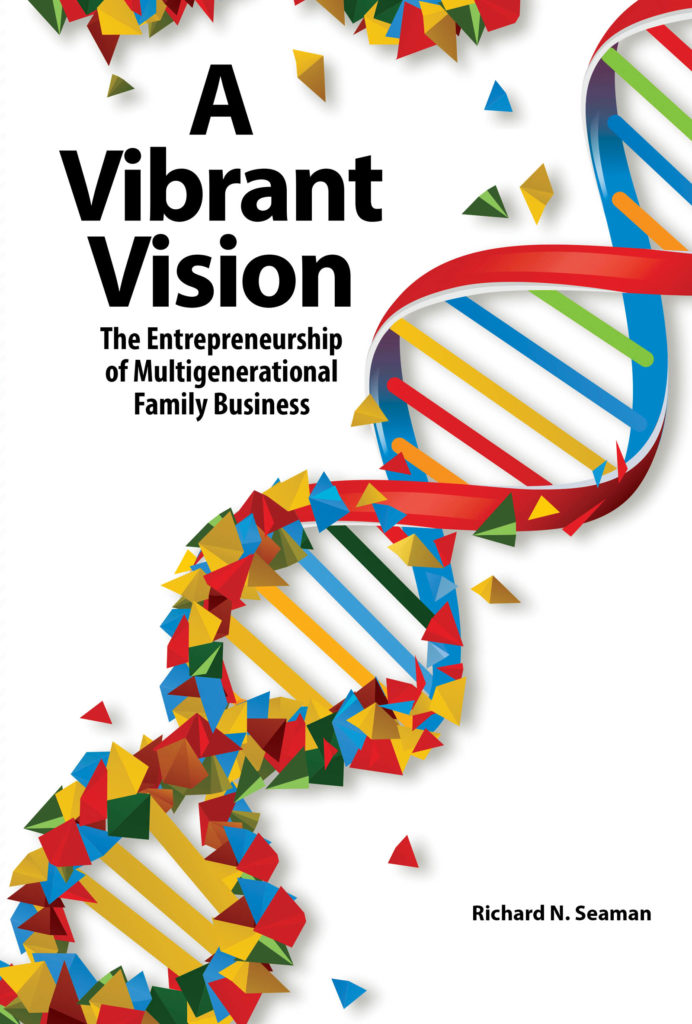By Rebecca Post
An urgency runs through the pages of Richard Seaman’s book A Vibrant Vision: The Entrepreneurship of Multigenerational Family Business. That urgency stems from Seaman’s understanding that few family businesses survive beyond a third generation. Seaman, the chairman and former CEO of Wooster, Ohio-based Seaman Corp., offers a model to family-owned businesses for long-term operation—rather than an all-too-common exit strategy of selling out through a “liquidity event.”
Seaman wrote the book over the course of two and a half years, motivated by the lack of information on growing and sustaining family businesses. “There’s a gap out there. There are no books out there on how to grow a family business to be multigenerational,” says Seaman. “Family business ownership is a privilege and stewardship responsibility, not an entitlement to an ATM.”
Seaman assumed the leadership of his family’s business in 1978 after his father, the founder of the company, died at age 55. Over the years, Seaman increased the company’s annual sales from $10 million to $200 million. He notes that Seaman Corp. is a U.S.-based company that actually exports industrial textiles into China.
“I wanted a business that would survive me,” says Seaman. He writes that a “family business survival ratio” is 30:10:3, according to a 2018 Ernst and Young Global Family Business Survey. The survey states that an estimated 30 percent of family businesses survive to a second generation, 10 survive to a third generation, and only 3 percent survive to a fourth generation and beyond.
Seaman sees family businesses as the backbone of the economy. In North America, eight out of 10 businesses are family owned, generating 64 percent of the gross domestic product, estimated at $5.9 billion, according to the Family Business Review. Family business are not just small mom-and-pop shops; some of the largest businesses in the U.S. are family owned, including Milliken & Co., Walmart and Ford Motor Co.
Seaman’s parents, Norman and Irene Seaman, started the business in 1949 with two sewing machines, stitching lace around doll diapers. “My parents were children of the Great Depression,” explains Seaman. Their goals were to acquire enough cut and sew work to feed the family and build a business where their five children could work. Norman, possessing an entrepreneurial and curious mind, began mixing formulations in the family kitchen that over the years resulted in vinyl-coated industrial fabrics for truck tarps, architectural and environmental textiles, single-ply membrane roofing and military applications.
The DNA of innovation
This innovative spirit for product development naturally became a big part of Seaman Corp.’s DNA. But over time, Seaman also recognized the importance of benchmarking what other successful companies are doing. One of Seaman Corp.’s current strategic objectives is to have 20 percent of its sales come from products that did not exist five years ago, a metric derived from benchmarking Rubbermaid goals.
Seaman also writes about the value of articulating a company’s “secret sauce”—that is, a company’s key advantages. In Seaman Corp.’s case, five basic technology platforms form that secret sauce: fabric formation, compounding, coating, finishing and fabrication. Seaman visualizes these platforms as a ribbon of DNA that incorporates materials, processes and intellectual property.
As the company grew, Seaman recognized it was time to professionalize business functions. First among these efforts was formalizing the human resource function. Then, succession planning called for creating the second-in-command position of chief operations officer. A commitment was also made to developing the company’s human capital, because, as Seaman writes, “growth will be dependent on the quality of people who work in the business.” All employees were trained on the quality principles of Dr. W. Edwards Deming. Employees later received training on Lean Six Sigma principles, resulting in improved quality, flexibility and capability, providing significant improvements in areas such as on-time delivery and inventory turns.
Governance and shareholder education
Governance is a big issue in family businesses. Seaman writes, “Today, family businesses of all sizes are still burdened by the dominance of family members on the board, adversely impacting the true role that governance should play in growing a business.” In the decade following his father’s death, Seaman built an effective outside independent board of directors to help set the expectations for family shareholders and motivate himself as the CEO/owner to a higher level of performance.
Shareholder education is also taken seriously at Seaman Corp. “Keeping the family business alive by teaching future generations the sacrifices, the values and the culture of the founder’s generation will instill principles of stewardship,” writes Seaman. An emphasis is put on helping young family shareholders understand the value of a work ethic, the economics of making a living and the responsibility of stewardship.
Work-life balance
When Seaman was in his twenties and thirties, he lost significant business and personal influences in his life, including his father, to early deaths. “I never took for granted that I would survive to the age of 60,” says Seaman. He realized he had to make his personal health a priority, and he cultivated hobbies like photography, snow skiing and water recreation.
He writes, “I decided that if I were the most successful businessman in the country, but that success came at the expense of my health, of my marriage and my family relationships, or if my children did not grow up to be responsible and accountable, then I would consider myself a failure in life.”
Rebecca Post is the editorial director at IFAI.
SIDEBAR: Trust matters
“People buy from people they know and trust,” says Richard Seaman of family businesses. A 2017 Edelman Trust Barometer report states that globally, 75% of people would prefer to do business with a family business, and 66% are willing to pay more for a product and service that comes from a trusted family business. Of the people surveyed, 54% said they prefer to be employed by a family business.
Richard Seaman’s book A Vibrant Vision: The Entrepreneurship of Multigenerational Family Business is available on Amazon and at www.vibrant-vision.com.
 TEXTILES.ORG
TEXTILES.ORG



